5 January, 1999
5th January
Pole Temp:
min. -31.6 C
max. -29.8 C
F=1.8C+32
Wind Chill -20 F
A Day at McMurdo a Night at the Pole
McMurdo is the largest of the U. S. stations in Antarctica. It was
established in 1956 and named after the sound which James Clark Ross
in 1841 named after Lt. Archibald McMurdo of the ship Terror. "Mac
Town" is a busy hub of activity as a research facility and point of
departure for many scientists deployed into the field by Hercules
LC130 aircraft of by helicopter.
The Chapel of the Snows found in town houses services of worship
on Sunday mornings at 9:30 AM for Protestants and at 11:00 AM for
Roman Catholics. On Wednesday evenings services of prayer and praise
are held. I was surprised at the ornate appearance of the sanctuary.
The chancel window depicts the elements of communion and a penguin
(the only penguin I saw in McMurdo, save for the drawings on the
sides of various buildings).
The Scott Discovery Hut, built in 1902 is just on the edge of town
and was used more extensively by other expeditions after Robert
Scott's than by Scott and his men. When inside, you can see some
supplies lining the shelves, a stove and a few other odds and ends
left behind by the members of various expeditions. Around the side
of the hut lies a mummified seal. A seal blubber stove was used
by the Ross Sea Party taking shelter there in 1915 and 1916.
A short walk uphill from Scott's hut is will take you to Vince's
Cross which is a memorial to Seaman George T. Vince who was killed
as he fell from a cliff into McMurdo Sound in 1902.
As the time for our departure for the South Pole drew closer,
the conditions of the road to "Willy" field became worse. We had to
travel by Delta transport to make our flight. Our flight
crew travelled with us. We were greeted with "You again!"
when we boarded the Hercules for our flight south. Save the
crew, Ryan and I were the only passengers. The huge belly of the
plane held a fuel tank.
During the flight to the pole, I just got a glimpse of the
Transantarctic chain of mountains through the clouds. Next, came the
polar plateau and about three hours later we were descending to the
pole. Just when one wants to look out the window, she has to strap
in for landing. The plane taxied for quite a bit, then stopped. I
looked out the window and there flapped the colorful flags of the
nations that had signed the Antarctic Treaty of 1959. Just beyond
the flags, a red and white striped barber pole topped with a silver
orb marked the Ceremonial South Pole. A short distance to the right
was the unpretentious brass-capped pole that marked the position of
ninety degrees south--the geographical South Pole. The new marker
for 1999 had just been placed at the spot just five days ago, the
sign with the quotations of Admundsen and Scott had not yet been
moved back to the pole's position.
I expected to receive a blast of cold that only the bravest of
people could withstand the moment we stepped from the plane. There
was none, and I was still breathing. The only pain was coming from
my shoulders while trying to handle two orange bags of belongings and
a purple backpack. The area manager, Mike Masterman wisked us
inside the Admundsen-Scott South Pole Station for a briefing in
the upper galley; other Polies looked over the newly arrived beaker
(scientist) and TEA. Soon I was on the back of a snowmobile, our
duds were loaded on a sled pulled behind, and Ryan was swinging back
and forth while riding standing up on the back of the sled.
We landed the end rooms on either side of the hall in Jamesway #11.
The sun shone in the window of my 6x8' room, and it was warm.
I left the unpacking for later and headed for the poles. About
11:20 PM in bright sunlight I touched the marker at 90 degrees
south. I was visitor #...........................?

Halo & Teacher Experiencing Antarctica: Sue Bowman standing at Ceremonial Pole with sun halo, "sundogs," and circumzentih arc. (photo: Lisa Beal)
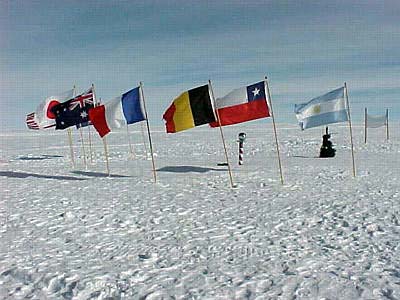
The Ceremonial Pole offers a bright contrast to it's white surroundings.

We headed for the Jamesway tent by snowmobile.
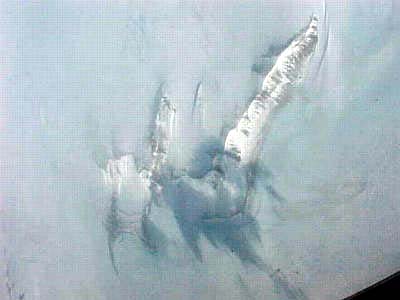
We flew over the polar plateau to land at the pole, 9,300 ft above sea level.

The Transantarctic Mountains appear below our Herc on the way south.
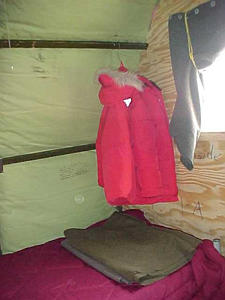
A Jamesway room at Pole measures 6 x 8' and varies in temperature throughout the 'night', but is generally comfortable.
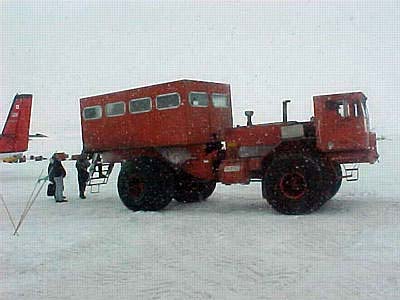
We were transported by Delta to "Willy" (Williams Field) near McMurdo to catch the flight to the pole.

The Admundsen-Scott South Pole Station that was completed by 1975, or "The Dome" reflects the color of the sky of the day. On cloudy days it blends into the snow in shades of gray, on sunny days it beams a deep blue.

Seal blubber was used in the stove inside the Scott Discovery hut by the members of the Ross Sea Party. This fellow remains on the porch, still waiting after 83 years.
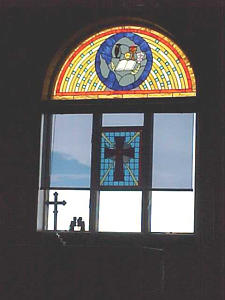
The chancel window at the Church of the Snows depicts its environment.
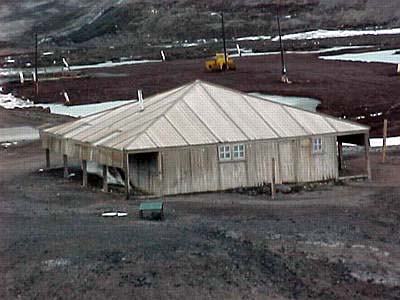
Scott's Discovery hut was a welcome shelter for several expedition teams that followed.
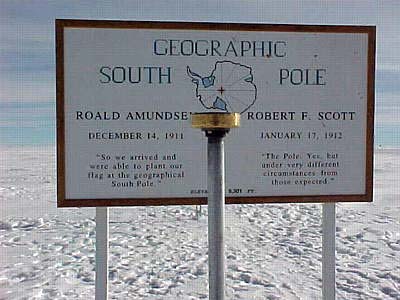
A ninety south (geographical South Pole) marker needs to be placed every year. The ice with the previous year's marker moves away from it's original position at about 10 meters (33 feet) per year toward the sea.
Contact the TEA in the field at
.
If you cannot connect through your browser, copy the
TEA's e-mail address in the "To:" line of
your favorite e-mail package.
|
